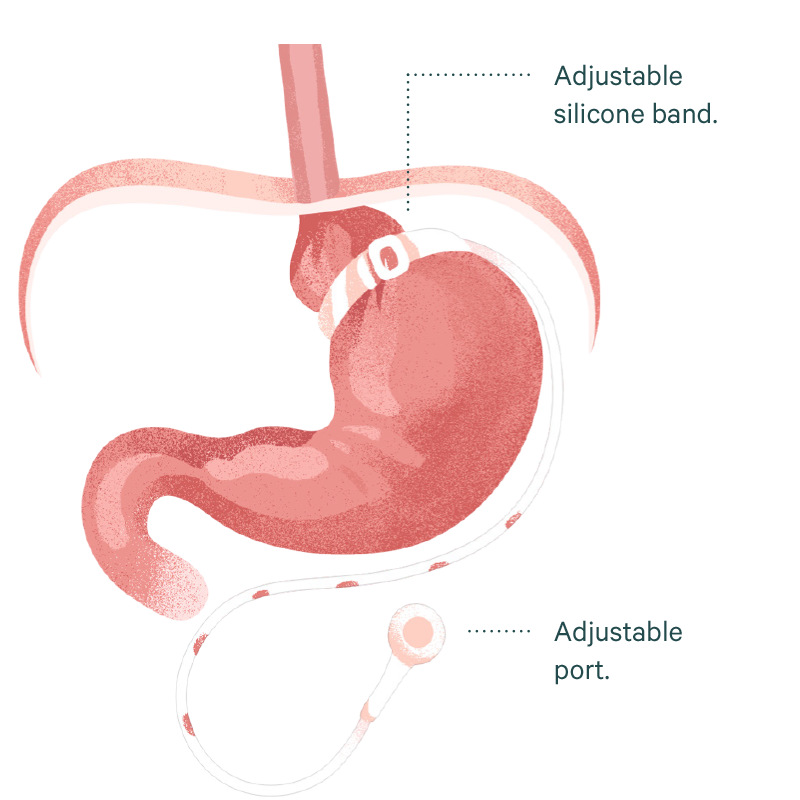Laparoscopic Adjustable Gastric Band (LAGB)

What is a Gastric Band?
An Adjustable Gastric Band is an inflatable silicone band that’s inserted around the upper part of your stomach, restricting the amount you can eat.
Is a gastric band suitable for me?
If your BMI score is over 35 and have other medical problems such as Type-2 diabetes, or high blood pressure, weight loss surgery may help you achieve your long-term weight loss goals. If your BMI score is greater than 40, you may be suitable for weight loss surgery.
What does the operation involve?
The operation is performed under a general anaesthetic and usually takes one hour. Surgical instruments, along with a camera are inserted through 3-4 small cuts on your abdomen.
During the procedure, a tunnel behind your stomach just below the join with your Oesophagus is created and a gastric band is wrapped around the upper part of your stomach. A few stitches are placed in the stomach to prevent the band from slipping.
An adjustable port is then placed under the skin to allow the gastric band to be inflated. The amount of fluid in your gastric band is adjusted according to your symptoms.
How soon will I recover?
You should be able to go home the same or the following day. You will be able to drink only liquids for a few weeks, moving to soft food and then to solid food.
You should be able to return to work after 1-2 weeks, depending on how much surgery you need and your type of work. Early light exercise is encouraged to help you return to normal activities as soon as possible.
What are the benefits of a Gastric Band?
Gastric banding is more effective than medication in achieving weight loss. It will help assist you in losing weight as well as improve some medical conditions associated with obesity like diabetes, sleep apnoea and high blood pressure. It is a reversible procedure and does not involve cutting or removing any parts of your stomach or intestines.
What complications can happen?
— Bleeding, infection of the band, difficulty swallowing, the band slipping, the band eroding into the stomach.
— Unfortunately, the gastric band has been associated with a high long-term complication rate, and a large number of gastric bands are removed or revised.
— The gastric band can cause long-term Oesphageal problems, especially if the band has been excessively tightened.
— Scar tissue formation, port malfunction and port infection are all significant complications that can occur.
A large number of gastric bands were placed in Australia previously. Patients with a gastric band require strict regular follow up, to ensure the best result and early detection of complications, if they do arise. There has been a trend around the world away from the gastric band, however there are still some cases where a gastric band would be a suitable option.
What is a Gastric Band?
An Adjustable Gastric Band is an inflatable silicone band that’s inserted around the upper part of your stomach, restricting the amount you can eat.

Is a gastric band suitable for me?
If your BMI score is over 35 and you have other medical problems such as Type-2 diabetes, or high blood pressure, weight loss surgery may help you achieve your long-term weight loss goals. If your BMI score is greater than 40, you may be suitable for weight loss surgery.
What does the operation involve?
The operation is performed under a general anaesthetic and usually takes one hour. Surgical instruments, along with a camera are inserted through 3-4 small cuts on your abdomen.
During the procedure, a tunnel behind your stomach just below the join with your Oesophagus is created and a gastric band is wrapped around the upper part of your stomach. A few stitches are placed in the stomach to prevent the band from slipping.
An adjustable port is then placed under the skin to allow the gastric band to be inflated. The amount of fluid in your gastric band is adjusted according to your symptoms.
How soon will I recover?
You should be able to go home the same or the following day. You will be able to drink only liquids for a few weeks, moving to soft food and then to solid food.
You should be able to return to work after 1-2 weeks, depending on how much surgery you need and your type of work. Early light exercise is encouraged to help you return to normal activities as soon as possible.
What are the benefits of a Gastric Band?
Gastric banding is more effective than medication in achieving weight loss. It will help assist you in losing weight as well as improve some medical conditions associated with obesity like diabetes, sleep apnoea and high blood pressure. It is a reversible procedure and does not involve cutting or removing any parts of your stomach or intestines.
What complications can happen?
— Bleeding, infection of the band, difficulty swallowing, the band slipping, the band eroding into the stomach.
— Unfortunately, the gastric band has been associated with a high long-term complication rate, and a large number of gastric bands are removed or revised.
— The gastric band can cause long-term Oesphageal problems, especially if the band has been excessively tightened.
— Scar tissue formation, port malfunction and port infection are all significant complications that can occur.
A large number of gastric bands were placed in Australia previously. Patients with a gastric band require strict regular follow-up, to ensure the best result and early detection of complications if they do arise. There has been a trend around the world away from the gastric band, however, there are still some cases where a gastric band would be a suitable option.